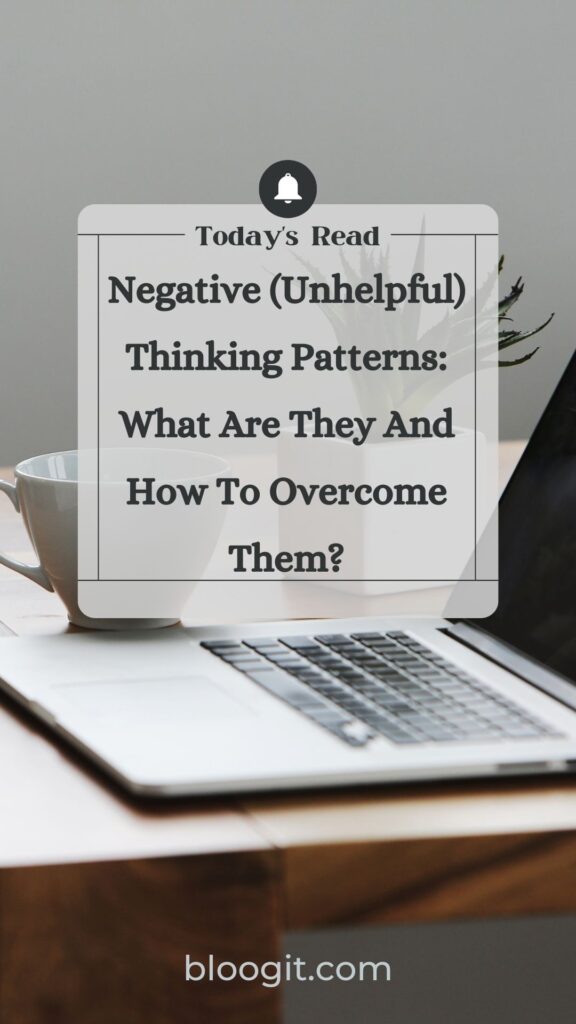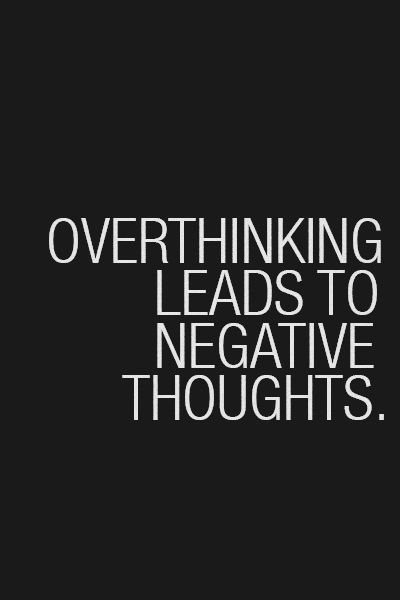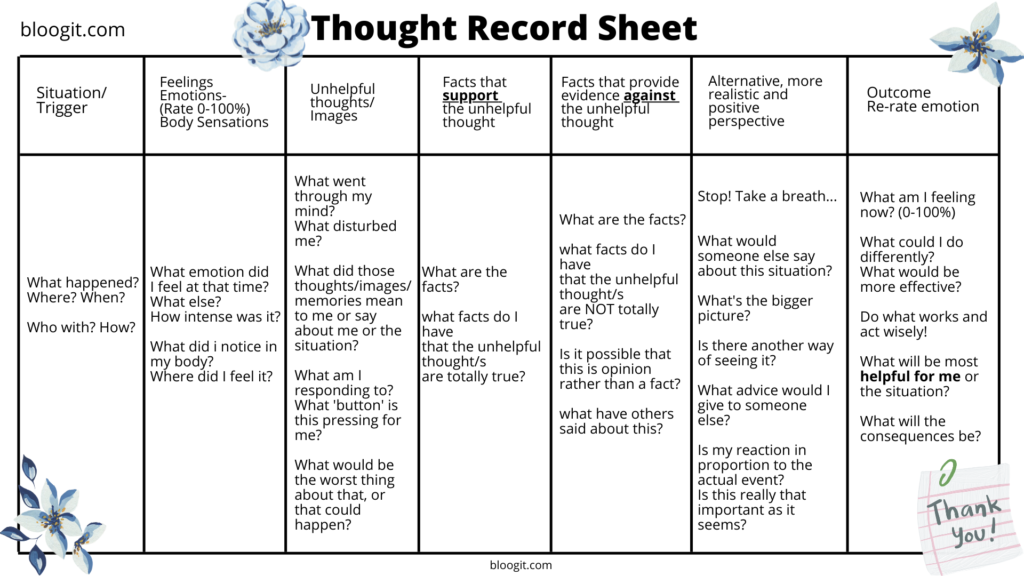There are a lot of factors that affect human thinking. Aaron Beck found some of these factors in his depressed patients in the 1960s and called them ‘cognitive distortions.’
Beck discovered that depressed patients had streams of negative thoughts that seemed to come out of nowhere while he worked with them.
He used the phrase “automatic thoughts” to describe the content of such thoughts, which he found to be classified into three categories: negative ideas about oneself, the world, and the future.
Patients would consider these automatic thoughts true even without having any proof, if they spent a little time meditating on them.
Beck began assisting patients in identifying and analyzing these thoughts acknowledging them as core beliefs and found that by doing so, patients were able to think more realistically, resulting in improved emotional and functional behavior.
He created key concepts in cognitive behavioral therapy (or CBT), demonstrating that various diseases are linked to various forms of distorted thinking.
He observed that a person’s core beliefs are revealed by repeated negative automatic thoughts, and emphasized that core beliefs are formed throughout the course of a person’s life.
This method in Cognitive therapy later on, has been used as an alternative solution and treatment for a variety of disorders, like: depression, bipolar disorder, eating disorders, drug abuse, anxiety disorders, personality disorders, schizophrenia, borderline personality disorder, and for patients who have had recurrent suicide attempts.
These negative automatic thoughts are known today as negative (unhealthy) thinking patterns (styles).
These words ‘Unhelpful Thinking Styles’ are less harsh than ‘Thinking Errors’ or ‘Cognitive Distortions,’ which helps the patients see the positive in their approach to restructure their thoughts in a more healthier ways and to heal from their traumas.
Cognitive therapy is the process of helping people overcome their wrong core beliefs, become aware of the negative (unhealthy) thinking patterns (styles) that keep them trapped in one place and begin to think in a more “healthy” way.
When we attempt to acknowledge, name, and correct our cognitive negative thinking patterns, we become less attracted to those harmful, hurtful, and self-defeating thoughts.
Although CBT has an alternative approach , which means that it is dealing with the leafs and the branches of the wound – we have to acknowledge that the rood of all the wounds can not be healed with just an alternative solution.
Speaking from experience what has helped me heal from deep wounds and traumas is this
in the bible it is written By the Stripes of Jesus Christ we are healed.
Which means only in the calling of the Name of Jesus in our lives that we can by His wounds be healed. This is the only way of dealing with the root cause of the problem and be healed from the wounds and traumas from of old.
Trust me, Jesus is the Only cure for the wounds.
May His wounds heal yours as you lean and trust upon Him for healing from your traumas and deep wounds.
This is my experience that by testifying to you all, I am hoping that it will encourage you and help you while you go through this process of healing.
Now Let’s See The 10 Common Negative Thinking Patterns and How You Can Change Them
Let’s look at one example.
Handlers in India begin teaching elephants by tying one of the elephant’s legs with chains to a tree.
They progressively reduce the size of the chain until the elephant’s leg is held only by a thin rope.
The interesting part in all of this, is that even if the robe is thin, the elephant stands still thinking he’s tied to a tree by a huge chain and can’t get out (or be free). If we look even deeper, it’s not the rope that holds the elephant tied, but his mind. That’s how handlers teach elephants to behave in certain ways, putting mental obstacles and letting them believe that they can’t go any further than the tree – in other words to believe that they are not free but slaves.
Similarly, this happens in our lives as well, when we are not aware of the thoughts that come into our minds as spiritual arrows from the evil one, or when we tend to believe the lies said from people’s mouth.
Just like the elephant we may limit ourselves because we so easily believed the lies about ourselves, our situations, and others that we eventually became stuck just like the elephant.
I wish we could question more the lies, and stick closer to the truth about us, because most of the time we do the exact opposite.
Our brains have the tendency to remember more easily the bad experiences, because of too much fear, anxiety, feelings of danger, paying more attention in those situations, being more aware of what is happening, and a lot of other factors.
If we don’t try to replace those thoughts on time, it might grow big and get in our way of happiness, increase our stress and worry in difficult situations and even damage our brain and health.
By working on those negative (unhealthy) thinking patterns we can discover that life isn’t that bad and dark as others presented to us. We won’t look at the past no more, nor try to dig into the difficult past experiences we had, but we start thinking outside the box without having any limitations.
Often times, the way we see everything, can be through unhealed childhood traumas or self doubt or hatred about who we are, just because someone else mistreated, abuse or hurt us in certain periods of time.
In other words, how we see the world can be determined by the environment in which we grew up, our family, religion, school, life experiences as well as the functionality of our physical brain (or how it is developed over life time), our memories, beliefs, and the attitudes toward ourselves and others.
And because our brains, add their own subjective point of view to incoming information, every one has their own perspective about themselves, others and on the world in general.
The question is do you see through the lens of the Truth and know who you are? Are your thoughts and opinions really based in the Truth or they are just misconceptions? How to know the difference?
Prayer to ask God Jesus Christ for help is highly advised so that He might lead to to the truth about yourself to develop healthy opinions about others and the world.
Ask and it will be given to you; seek and you will find; knock and the door will be opened to you.For everyone who asks receives; the one who seeks finds; and to the one who knocks, the door will be opened.
Matthew 7:7-8
So first, let’s take a look at what are the negative (unhealthy) thinking patterns and what they mean?
All or nothing (Black and white thinking)
Examples:
– If I’m not perfect I have failed. Either I do it right or not at all.
– A straight A student receives a B on an exam and concludes, “Now I’m a total failure.” or “I am a complete failure at everything.”
– Can you be absolutely brilliant or totally stupid?
– I am not pretty because I don’t meet the world standard of what it means to be beautiful. I am ugly. Can you be completely attractive or totally ugly?
– You started a new diet, and for the first few days, you’re eating according to plan. And then, you have a sliver of apple pie. You berate yourself for not being perfect and tell yourself, “I’ve blown it, I might as well just eat the whole pie! I’m such a failure!”
To put this as simply as possible, it means thinking or seeing things in extremes: black-and-white thinking. No shades of gray. If things aren’t perfect, you see them as a failure.
You think you are all or nothing, good or bad, successful or a failure.
One mistake and you believe that you’re a loser, that you suck at what you do, and that you are a failure. The examples are endless.
You’ve set yourself up for constant self-discredit, no matter what you do, as you will never meet the exaggerated expectations you’ve set yourself.
And this type of thinking can lead to stereotyping people, situations, relationships or the world in general.
How did you concluded that ”A person isn’t all good or all bad,” because situations and circumstances change.
Thinking black or white will keep you fixed in one spot, disabling you to make progress and move forward.
Let us know bellow if you find yourself thinking like this and what are those thoughts?
Over-generalizing
Examples:
– ”You never help me with the housework.”
– “She always has a go at me as soon as I get home.”
– You’ve asked someone out on a date, and they say no. Your automatic response is,
“I’ll never find someone to go out with me. I’ll be lonely for the rest of my life.”
– “Everyone hates me.”
– “Bad things always happen to me.”
This is all based upon past experiences that can really blur your view of things.
The most simple understanding to over-generalization is that you arbitrarily conclude that due to a prior occurrence, a situation will occur repeatedly, multiplying and, because what happened was unpleasant, you feel upset. For example, the pain of rejection comes as a result of over-generalization.
This is also characterized by certain words such as ‘never’, ‘always’, ‘every’, and ‘all’. People who think in this manner frequently begin statements with phrases like “She always,” “He never,” “They all,” “Everyone.”
Simply put, if something happens to you, it “always” happens to you. Or you want something to happen, but it doesn’t, and you feel it “never” will. These thoughts are upsetting and might lead to a cycle of defeat.
Perhaps you have been hurt in the past by someone’s behavior and now this is all you can see in relationships. This will eventually cloud your perspective. You might end up approaching the new situation with an old and prejudiced mindset, unable to form new opinions.
Mental Filter
Examples:
– “Why did he compliment my dress but not say anything about my hair?”
– “The reason I passed that test was that the questions were easy.”
– A depressed student heard others make fun of her best friend, which made her furious as she thought, “that’s what the human race is basically like, cruel and insensitive.” She overlooked the past months where few people, if any, had been cruel to her, or her friend.
– A student score A’s on all his tests except one which was a B. Instead of being pleased about all the A’s he achieved, he focused on the one thing that wasn’t good enough and got disappointed about it.
– Your partner took you out for a romantic meal, but all you can remember was that they didn’t open the car door for you.
So, Mental Filter is picking one negative detail out of all the things going well and positive, and focusing all your attention on the negative.
Filtering out the positive and focusing on the negative is associated with traumatic and survival situations (especially in childhood). In the past, that which was suppose to be a normal situation became potentially threatening. If a person grows with this kind of mindset, by tuning into the negative aspects of every situation, that person will surely view the world as dark and negative and is more likely to be unhappy and sorrowful than joyful.
Always casting yourself in a negative light can lead to constant feelings of unworthiness, anxiety, and even suicidal thoughts.
Disqualifying the Positive
Example:
– You sang beautifully on stage but didn’t hit one note correctly, that’s why you convinced yourself it wasn’t good enough.
– When someone praises your looks or work effort, you automatically tell yourself, “they’re just being nice.” With one swift blow you mentally disqualified their compliment into a negative. You then do the same thing to them by responding, “Oh, it was nothing, really.”
– You have a positive experience and tell yourself, “that was a fluke.”
– You have a negative experience, dwell upon it, then conclude “that proves what I’ve known all along.”
This thinking pattern means qualifying the positive experiences, which will then lead you to feel inadequate or unappreciated.
When did this behavior toward yourself and others started ?
This learned negative thinking pattern is coming from a traumatic experiences in childhood. When you as a child was viewing the world around you (that’s the family) as positive, but the family showed abusive or violent behavior, which crushed the spirit within you.
Usually from being criticized from the parents, the caregivers, teachers or friends as you grow up. This developed your brain to SEE only the negative, discounting the positive. The glass in this case, is half empty not half full.
Now you become more aware of the fact that the home that was suppose to be your safe place becomes the nightmare. Building up those thoughts over the years will eventually convince you that the whole world is the same as the home you grew up in.
Now you start seeing negative and life threatening situations even if there are none. Just because that which you expected to be good in the family turned out to be the worst, now in the positive you always focus on the negative or tend to see the negative just in case, so that you might be prepared mentally for anything.
The people who think this way, might not easily accept quick changes , or are finding it hard to adapt to huge changes (like moving from one place to another, or one apartment to another) because they are so used to the way they ordained everything in life. Even small changes can be difficult for them.
This unhealthy thinking style is similar to the example: if you constantly throw cold water on the good things in life, then the only outcome you’ll get out of your life will be such coldness without feelings of any warmth (positive).
Which will lead to an intensely miserable life where one fails to appreciate the good things that happen.
Tip: Counting the positive is the opposite of this behavior. That is why people tend to have a gratitude journal to keep counting the everyday blessings that the Lord Jesus Christ gives them. I know it’s hard especially if we were living in these places of negativity for so long in our lives. And I know, it will take quite some time to learn the opposite of this negative thinking pattern. But know this: it is worth it! It is so worth it! When the concept of thinking will change as we push toward the negativity with the positive that happens everyday even if they’re small ones, we will begin to see the light in our lives and start viewing our world full of joy, happiness and even more gratitude. You can start by writing one thing at a time, or the things you see beautiful in yourself, every day, for 30 days. And see what happens.
Prayer: When it comes to our true identity we often can’t see the true selves or the beauty within. That’s why we suggest praying to Jesus with simple words: “God show me who I am and how beautiful you see me, in the name of Jesus.” Write those thoughts or maybe memories that God will remind you of, and as they come into your heart each day you’ll begin to see through in a whole new light.
Jumping to Conclusions (Mind reading and fortune telling)
Examples:
– Whilst giving a lecture an audience member nods off to sleep. Your thoughts are along the lines of, “this audience thinks I’m boring.” The reality, though, is that this person was up all night with their sick child, but you do not know this information.
– A friend passes you on the street and fails to say hello. You may automatically conclude, “he is ignoring me so he must not like me anymore.” If you asked him, you would find he was simply distracted in deep thought about a matter and didn’t even see you.
– Your spouse is unresponsive one evening after being criticized at work, and is too upset to talk about it. You interpret their silence as, “they must be mad at me, what did I do wrong?”
– “This treatment won’t work for me, I’m doomed to be like this forever.” Before giving treatment a shot, the person has already foretold that it won’t work for them, thus they entered with a negative attitude of hopelessness, yet without any reality to substantiate their outcome.
– You called someone and left a message, they haven’t called you back yet. You concluded that the person wasn’t interested in you, or returning your call. Worse, you then find reasons to not call them back, perceiving they think negatively or of you.
– “I messed up, they must think I’m an idiot.”
– “His parents will hate me.”
– “No one will like me at my new college.”
Mind reading example: You seem to know exactly how someone is thinking. You often interpret an action or response and conclude that you’re not liked or that someone is angry with you.
Fortune-telling example: You already know you’re going to struggle with something before it has even started.
This means jumping to a negative conclusion before having all the facts. Your conclusions are based on an assumptions and its either what you think others are thinking or that you believe the future only holds negativity or nothing good for you. Comes out of the thoughts you developed when younger that you don’t deserve anything good.
Maybe your assumptions are based on feelings and not hard evidence? feelings are good. They are blessings from God but hard evidence is also welcomed in order to have good judgment of the situation.
If not being aware of it will lead you down the wrong path, because we can never assume another person’s thoughts.
n mind-reading, you make an assumption that others are looking down on you, and you’re so convinced about this that you don’t bother checking further facts. This presumption places you in a position to possibly withdraw or even counterattack negatively, all because you assumed what another thought.
Fortune-telling is similar in concept, seeing the future in negative way, or foretell things negatively about your life, regardless of reality. Fortune-telling often leads you to believe something bad is going to happen.
Magnification (Catastrophizing) & Minimization
Example:
– You agreed to pick up milk on your way home from work. With a lot of things on your mind, you forgot. In your mind, you become the most forgetful, unreliable, disorganized person there is!
– You think of your abilities as poor, lacking, or inexperienced.
– One woman confessed: “I catastrophise a lot. It’s how I came to develop my travel phobia. I always imagine the worst-case scenario. If I’m driving somewhere new, I feel anxious before I leave and start to think about everything that can go wrong with the journey”.
This means you’re either blowing things up out of proportion (catastrophizing) or shrinking them down. The most common area of magnification is when you look inwards at your own errors, fears and imperfections, exaggerating their significance, making it bigger than it really is. Or you’re able to minimize the situation and your positive qualities.
When you think about your strengths, you may do the opposite, making things look unimportant. If you magnify your imperfections and minimize your good points, then you’re guaranteed an outcome of feeling inferior.
If you always assume the worse, try acknowledging the thoughts and using logic to combat your emotional responses.
Emotional Reasoning
Examples:
– I feel worthless; therefore I am worthless.
– I feel guilty; therefore I must have done something bad.
– I feel overwhelmed and hopeless; therefore my problems must be impossible to solve.
– I feel inadequate; therefore I must be a worthless person.
– I’m mad at you; this proves that you’ve been acting rotten and trying to take advantage of me.
– You’re anxious about driving so you’ve concluded that driving is unsafe.
– “I feel like a fraud, therefore I am a fraud.”
This cognitive thinking allows you to believe that whatever you’re feeling, it must be so. This kind of reasoning is misleading because your feelings reflect your thoughts and beliefs. Or when you take your emotions as evidence for truth or fact.
Emotional reasoning is strongest in depression and anxiety, as things feel negative or fearful to you, so you assume they truly are. It doesn’t occur to you to challenge the validity of your perceptions that create your feelings.
Procrastination is a side effect of emotional reasoning. You avoid cleaning up your home because you tell yourself, “I feel so lousy when I think about the mess, cleaning it will be impossible.” At a later date you push yourself to clean your home, and as it turns out you were wrong – it was actually quite gratifying to you afterwards and not so tough at all.
It’s easy to allow your negative feelings guide your actions, but keep in mind while acknowledging what you are feeling is good, acting according to your negative feelings is not. especially if you put a label on yourself because of those negative feelings.
“Should,” “Must” And “Ought” Statements
Examples:
– “I should have done it my way instead of listening to you. It’s your fault it didn’t work out.”
– You should have done it as I told you not as you want it to be.
– When my mom was fighting for her life because of Covid I told my sister who wasn’t present at that time with me: “where were you? You should have been here,” even though it was impossible for her to fly from another country, because of work obligations.
– I must do this otherwise they are gonna be mad at me (not like me).
– You ought to do this otherwise we are gonna fire you.
“I should do this” or “I must do that” – are pressure statements, often leading to resentment. You’ll be left with feeling apathetic and unmotivated, and the result will be the contrary to what you were trying to achieve. In other words, “Should, must and ought” statements generate unnecessary emotional turmoil. The reality of your own behavior falls short of your standards, your “should” and “should not” statements create self-loathing, shame and guilt.
Also you might have a clear idea about how things “should” or shouldn’t” be. When they don’t turn out that way, you blame yourself or others. When you direct “should” statements towards others, and when their performance falls short of your expectations, you feel bitter, frustrated and self-righteous. Your choice is to either change your expectations of others, or go through life constantly feeling let down.
Labeling
Examples
– When your invested stock goes down you think, “I’m a failure” instead of “I made a mistake.”
– A woman on a diet eats a dish of ice-cream and thinks, “how disgusting and repulsive of me. I’m a pig.” These thoughts made her upset, resulting in her eating the entire bucket of ice-cream.
This is an extreme form of over-generalization. Chances are you’re involved in personal labeling when you begin a sentence beginning with, “I’m a…” taking the evidence out of context.
This can also be like all-or-nothing thinking. You label yourself in a negative way when you’ve done something you or others don’t like. You don’t realize that you are not your behavior. Similarly, when someone else does something you don’t like or makes a mistake, you label them, writing them off as if their behavior is who they are.
For example: You give someone directions that turn out to be wrong. Instead of recognizing you’ve made a mistake, you label yourself – “I’m such an idiot!” Or, you give someone else a label when he/she disappoints you or makes a mistake – “She’s stupid and a liar!”
Labeling is not only self-defeating, it is irrational. Your self, your being, cannot be equated with any one thing you do. Your life is a complex ever-changing flow of thoughts, emotions and behaviors.
Labeling is nonsense, but such nonsense becomes painful when you label yourself from a sense of your own imperfections and weaknesses.
On the other hand, labeling others generates hostility. A boss labeling his irritable secretary as an “uncooperative b**” is a common example of it. Now both of them are resentful toward each other, and this negative cycle repeats itself, with a focus on each other’s weaknesses and imperfections as proof of the others worthlessness.
Personalization / Critical Self (Self-blame)
Examples:
– A client doesn’t do a self-help assignment between sessions, thus the therapist thinks, “I must be a lousy therapist. It’s my fault that she isn’t working harder to help herself. It’s my responsibility to make sure she gets well.”When a mother sees her child’s report card with a note attached referencing the child not doing well, the mother thinks, “I must be a bad mother. This shows how I’ve failed.”
– “I always mess up, no wonder no one likes me.”
– “I’m such a loser.”
– “Everything is my fault.”
This type of thinking is the mother of all guilt. You assume responsibility for a negative, even when there is no basis or evidence for doing so. You conclude that what happened was your fault or reflects your inadequacy, even when you were not responsible.
Personalization causes you to feel crippling guilt. You suffer from a paralyzing and burdensome sense of responsibility that forces you to carry the whole world on your shoulders. You have confused influence with control over others. In your role as a teacher, parent, counselor, physician, salesman, executive, or boss, you will certainly influence the people you interact with, but no one could reasonably expect you to control them. What the other person does is ultimately his or her responsibility, not yours.
We gotta understand that taking responsibility when things go wrong is certainly the right thing to do. But blaming yourself for every little thing is an unhelpful style of thinking.
What’s more frightening is if one starts believing he is guilty for everything, than this personalization becomes a self-fulfilling prophecy.
Even though this type of thinking might come automatically, as already learned pattern of thinking and behavior, believing those lies will only leave you feeling unloved.
Treat yourself with kindness. After all, you wouldn’t call a friend or loved one a loser or guilty every day, would you? So why are you doing it to yourself?
The other side of it, is this: If you are not able to deal with guilt because you personalized everything to be your own fault, then you blame something or someone else, you don’t have to look at your part in the situation – which is playing the “blame game.”
The truth is you just hold yourself responsible for events or things you don’t have 100% control over.
For example: Your child gets into trouble at school, and instead of being curious about what happened and why, you blame yourself for being a terrible parent. Or, you blame others for your child’s challenges at school: “It’s the teacher’s fault that my child is in trouble. She’s a terrible teacher.”
Read More about guilt in the article “Scapegoat – What is it?“
5 Steps To Change Your Thinking
The strategies outlined below challenge each one so that you can begin to think more effectively and realistically. As you practice these, you’ll find yourself feeling better – about yourself and others.
Step 1: Identify Your Negative (Unhealthy) Thinking Patterns
Keep a journal. As you become familiar with the 10 negative (unhealthy) thinking patterns, notice which ones you seem to favor. Writing down your thoughts will help you keep track of what you’re thinking about and how you’re feeling.
Step 2: Next, Challenge Your Thinking
Next is is very important to challenge your thoughts because not all of our thoughts are true! As you write down your thoughts and the corresponding negative thinking pattern, ask yourself:
Is this really true? Do I know this to be true, for sure? Have I checked the facts?
Take a step back and assess the situation again. Continue challenging your thinking with other questions such as “Am I really a bad person?” or “Could it be that she was doing the best she could and just made a mistake?” or “When would this not be true?”
Here is the list of Thought Record Challenging Table that you can use to write the negative thoughts and what evidence you have and the opposite of it with the evidence to back it up.
Step 3: Compassionate Self-talk
We are often extremely hard on ourselves. Our self-talk is harsh, negative, and sometimes abusive. When you think about how you would speak to a good friend, chances are you’d never say to your friend the things you say to yourself.
For each negative thought you’ve identified, write down the opposite of it, just like the way you would respond to a good friend. Then, practice using this more compassionate self-talk with yourself.
Step 4: Seek Support
Find a friend or someone you trust to help you challenge your assumptions and negative thinking. The right questions can help you shift your perspective from black or white to shades of grey! Creating some flexibility in your thinking can help you lower your stress, feel less anxious and shift away from depression.
Step 5: Positive/Negative Outcomes
Self-assessment is key to finding the mental and emotional freedom you’re looking for as you challenge your own negative thoughts. By asking yourself some questions might help you decide whether it’s worth keeping or changing the thought:
– How will it help me or hurt me if I believe this thought?
– Will it move me closer to being the person I want to be or farther away?
– If I continue to believe this thought, how will it impact my relationship(s)?
– How do I feel about myself when thinking this?
– Does believing this helps or harms my depression, confidence, self-worth, anxiety, etc.?
Challenging your negative thoughts does take practice and patience, but your life will become so much better as you take control of your thoughts instead of allowing them to control you.
It’s obvious that there are many unhelpful thoughts, but this doesn’t mean you have to stay trapped in it. Every time you find yourself thinking negatively, stop, write it down and than challenge those thoughts.
Think to yourself, is this your true reality or are you basing your thoughts on something else? This simple approach can become effective and you can break free from your mental barriers.
Conclusion
There are many negative thinking patterns hat we have learned in the environment we grew up in. Nevertheless, the reality that was presented to us as the way of living doesn’t have to mean that we should adapt the same behaviors and thought patterns the way we live in our life.
We are responsible for our lives. What other did is only on them.
If we learned negative thoughts and behaviors – it’s time to write it down and identify which ones we are entertaining in our minds.
The best way to do it, is through journaling and the negative thought record – where you can challenge every thought that stands on your way.
If there are any traumas or thoughts that you are struggling with and can’t find a solution to it, please do write via About Bloogit page. We wanna help you!
We also recommend a great therapist and a counselor, so if you are interested to know more please write us via the About Bloogit, with the words: “Hey, I wanna know more about the counselor you are recommending on your site,” and we’ll get back at you as soon as possible.










This is an excellent article. I started therapy about forty years ago and hated Cognitive Therapy. The message I received back then was “If you think positive thoughts, your life will be better” which in my life was a lie. What I failed to understand was all of the negative thinking that goes on automatically are the thoughts that overtake any conscious positive self-talk I might do.
Thank you for your research and the way you present it in an understandable way.
Roxanne, I am really sorry for the things you’ve gone through. It must have been very hard.
I know for sure, that Jesus Christ came to deal with the root of every problem.
Forgiveness and freedom can be found only in Him.
When a person is set free, with the help of the Holy Spirit starts building a firm foundation full of God’s love and truth.
That’s why this article helps only, for us to recognize the tactics/strategies, ways of thinking, the lies that often attack us.
Although this article serves as a recognition of negative thinking, the true way to deal with all the lies is with the Word of God – which truly sets us free from any bondage.
I thank you for taking the time to read and comment on the article. I really appreciate it.